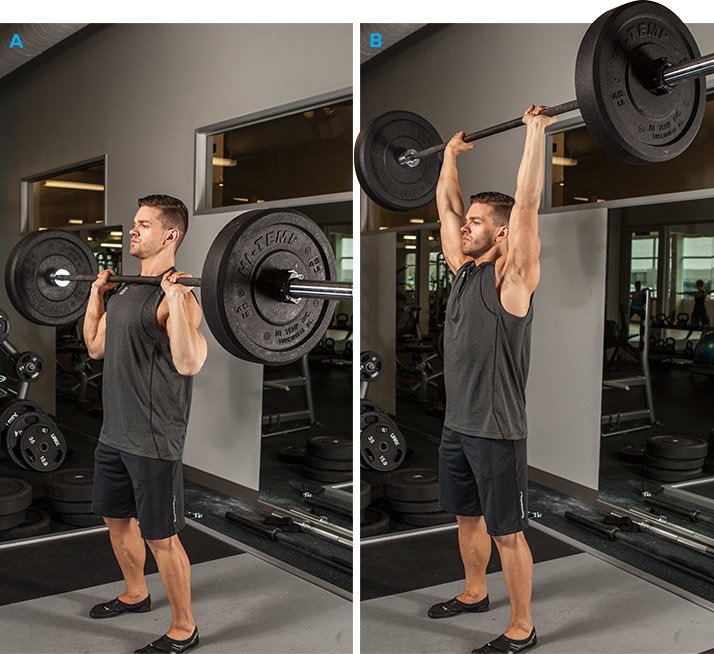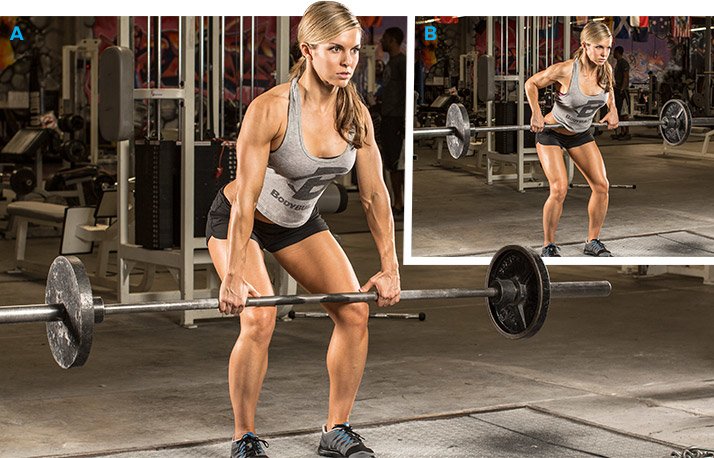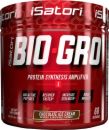
If gym exercises could compete head-to-head like your favorite college football teams, we might finally and unequivocally be able to determine the best possible movements for every body part, bar none. Alas, since exercises can't exactly hit the field, we have to dig a little deeper to pit them against one another.
To create this particular list of best muscle-building movements, we utilized EMG analysis—an electrodiagnostic technique that measures muscular electrical activity—scoured recent scientific research, examined which movements allow you to best overload the target muscles, and took into account the opinions of leading experts.
Who helped choose this all-star exercise team?
- Parker Hyde, CSCS, CISSN
- A team of athletes from sports-nutrition company iSatori
- Author and educator Stephen Adele, CEO and founder of iSatori
Cumulatively, these panelists have decades of in-the-trenches experience coaching elite amateur and professional athletes.
"Any weight-training program that skips out on these fundamental, compound, maximum-growth exercises is horribly incomplete," says iSatori's Adele. "[Skipping these lifts] ignores movements like squats and deadlifts that signal the body to send surges of growth-boosting hormones that can cause you to grow—to gain both muscular size and strength."
In other words, what you see here are the stand-out movements—the best of the best—for each muscle group. These are the exercises you absolutely, positively must include in your training if your goal is to maximize muscle size. Once you've learned them, do them first in your workout when your energy levels are highest. Then, load them appropriately with very heavy weights so you can also focus on maximizing strength, which ultimately helps you build more size.
Shoulders
Best: Standing barbell overhead press
Major muscles worked: Middle and front delts, trapezius, triceps, upper pectoralis, serratus anterior

Why it's Number 1: According to Hyde, standing barbell presses should be a staple of every lifter's shoulder routine. "They require upper back and rear-delt stabilization, core activation, and strong legs. EMG research suggests that, compared to a seated dumbbell press, during a standing barbell press, there's significantly greater muscle activation of both the middle and front delts during a standing barbell press.1 This is extremely important since these are the two primary muscles that really create cannonball, capped delts."
In Your Training: "This should be one of your primary presses on either shoulder or push day," says Hyde. "If you wait too long in your workout to get it in, you'll be too fatigued to really train your delts with the intensity they need. While delts can usually be trained in a slightly higher rep range, this movement should be done similar to a bench press. Vary the reps from strength (three reps per set) to hypertrophy (8-12 reps per set)."

Why it's Number 1: "Front squats top the list for a couple of reasons," says Hyde. "Despite the location of the bar, the majority of the load and force should be located about midfoot. Bar positioning during a front squat is held high on the anterior delts and there's minimal change in back angle, which allows for more recruitment and activation of the quads [than other kinds of squats]. Bar positioning during a back squat will force the hips to travel farther backward, shifting a greater tension toward the hip extensors (glutes)."
Since quad exercises are more prone to putting added stress on the knee, Hyde also points out that front squats exhibit a lesser shearing and compressive force across the knee joint.2 This makes them a knee-friendly squat variation.
In Your Training: "Use the front squat as a primary movement for a quad-focused leg workout," says Hyde. "Not only does this exercise require leg strength, it also requires a strong upper back and core. If you lack flexibility, it's okay to either cross your arms over the bar or use lifting straps to hold the bar in a pseudo front-rack position."
Best: Barbell bench press
Major muscles worked: Pectoralis major and minor, anterior deltoid, triceps, serratus anterior

Why it's Number 1: Here's where you start on chest day, at least most of the time. "With a bar, you get the most power and therefore can press the most weight," says Hyde. "The bar is also easier to control than dumbbells. Several EMG studies have concluded that not only does the barbell bench press activate the pecs to a greater degree than incline presses, decline presses, and flyes, but it's also superior for targeting the triceps brachii."3,4
In Your Training: Put the bench press at the front of your workout for heavy sets in lower rep ranges. Your grip width impacts the amount of bar you can move. Research suggests a grip in which your forearms are 90 degrees to the floor (completely perpendicular) when the bar is in the down position.5


Why it's Number 1: "While using a barbell allows you to lift heavier weight, it can also lead to muscle imbalances if the stronger side takes over," says Hyde. "Using dumbbells can help (or prevent) strength and muscle imbalances, and also give you enough stimulus for muscle growth. Dumbbell curls can allow for a more natural movement and greater range of motion, and give you the option of varying your hand position—supinated throughout, neutral like hammer curls, and neutral to supinated as you turn the weight up as you curl—which can alter the activation of the different biceps heads to slightly different degrees."
In Your Training: Do biceps moves after multijoint pulling exercises for back if you're training them on the same day. If you follow a body-part split with a dedicated arm day, try loads in the heavier end of the muscle-building rep range for sets of 8.

Why it's Number 1: "EMG studies clearly show that bent-over rows hammer the entire back evenly," says Hyde. "This exercise exhibits significant increases in muscle activation across the back, with equal contributions from the lower back and lower and upper lats.6 When handling very heavy loads, make sure your lower back doesn't round when pulling, which can increase stress on the lumbar discs."
"Bent-over rows are my absolute favorite exercise for building a big back, and the main movement I attribute my back development to," says Team iSatori athlete Nick Wright. "I alternate between an underhand grip and an overhand grip, each of which is slightly different. The overhand grip reduces biceps activation, and I've found there are a number of ways in which it can be done.
My favorite has always been the Yates-style row, named after former Mr. Olympia Dorian Yates. I've also done them using Ronnie Coleman's style, in which you're angled about 45 degrees above the horizontal plane. Using a bit of momentum is fine so long as it is controlled, especially on the negative."
In Your Training: Again, do heavy sets in lower rep ranges, about 6-8 or 8-10 reps. The Smith-machine version is a good substitute; it locks you in the vertical plane, but your body has to be in the exact precise position relative to the bar. You can also try the reverse-grip version for a change, which puts slightly more emphasis on the lower lats and biceps.
Best: Hip-extension machine/butt blaster
Major muscles worked: Gluteus maximus and medius, hamstrings
Why it's Number 1: "One of the biggest series of published EMG data by a group out of Hamburg, Germany, found that that the lying hamstring curl with your thighs elevated and a forced contraction of the glutes activated the glutes best," says Hyde.7 "That's not exactly a common exercise, so here I'd go with the second best: the hip machine. It's basically simulating the stride you'd make as a sprinter (which can be done standing or on all fours). As you reach an extended position, you'll recruit the glutes. Really focus on squeezing the glutes, and don't just speed through the reps."
In Your Training: "This is a better isolation type of movement, so it's one you'll want to do after your heavy leg work of squats, deads, and/or hack squats," says Hyde. "This is really going to burn out your glutes, and they're prime movers in your multijoint leg exercises. Reps should be in the hypertrophy range (8-12) with a slow and controlled tempo."

Why it's Number 1: "Published EMG evidence tends to point out that dips done for triceps, in which you maintain a more vertical body position and restrict elbow flare, elicit a very high amount of triceps activation," says Hyde. "While other exercises may rank a bit higher in regard to triceps activation, the multijoint nature and ability to really control the rep speed, resistance, and chest angle with dips has it edge out other single-joint triceps moves." Hyde suggests the weighted bench dip as a good alternative.
In Your Training: To work in a muscle-building rep range, you're probably going to need a belt that allows you to hang added plates from your waist. Doing endless reps with just your body weight won't elicit much of the muscle-building effect you're after. As with any multijoint triceps exercise, do heavy dips first in your workout, adding weight so you can train toward the lower end of the target rep range of 8-10.
Hamstrings

Why it's Number 1: "One of the best exercises to really hammer the hammies is the Romanian deadlift (RDL). A recent EMG study demonstrated the superiority of the RDL in hamstring activation as compared to the leg curl, the glute-ham raise (GHR), and good mornings," says Hyde.8
Because the hamstrings cross the knee and hip joints, you need to include movements that work each, since no single movement works the entire muscle maximally. The RDL mainly works the hamstrings from the hip joint, so make sure you also include a knee-joint hamstring exercise like a leg curl in your routine as well to ensure complete overall development, advises iSatori VP of marketing Craig Stevenson.
In Your Training: "Place this as your first hamstring exercise of the day," says Hyde. "Stick to the 8-12 reps, but really push the weight. If you've never done RDLs before, watch yourself in a mirror from the side. Your goal is to have minimal changes in knee angle and to really force your hips backward. Keep your shoulders locked in, a big chest, and really fire the glutes on the way up. A good rule of thumb for how far back to stick your glutes is to keep reaching until your hammies start to quiver."

Why it's Number 1: "The same German group that reported on the glute exercise also found that the donkey calf raise had the greatest activation of the calves," says Hyde. "They also found that [using] a foot position with the toes pointed directly forward maximized recruitment of both medial and lateral heads of the gastrocs."
If your gym doesn't have the machine version of this exercise, it's time to get close to your training partner and perform these the way Arnold did—with someone on your back—to ensure you place sufficient overload on the target muscle.
In Your Training: "Do this exercise after you've completed all work for quads and hams. Since the gastrocnemius is recruited indirectly into many leg movements, you don't want them fatigued before you do these exercises," says Hyde. "Do this movement before the rest of your calf exercises, especially bent-knee movements in which work done by the gastroc is minimized. One training suggestion: Go higher rep and really force the eccentric on these!"

Why it's Number 1: "The barbell back squat tops the overall list for several reasons," says Hyde. "First, it activates the calves, quads, hamstrings, and glutes all the way to the erector spinae, upper back, and biceps. A massive body of research demonstrates the ability of squats, specifically done between 6-10 reps, to significantly increase testosterone levels.9 There are a number of ways to vary the exercise as well, by adding chains, doing box squats, or changing foot positions to emphasize different areas of your lower body."
Adds iSatori athlete Jason "Big J" English, "Squats are single-handedly one of the most important exercises for total-body strength, mass, and balance. No matter what type of training program you're on—whether it's an upper/lower split or a 4-5-day-a-week training program—great results are inevitable. Utilizing squats is most important in every aspect of any sport. So do them with intensity!"
In Your Training: "Current research suggests that placing squats earlier in your workout may transiently increase testosterone throughout the workout," says Hyde. "This would theoretically improve the response of the smaller musculature in subsequent working sets. Shoot for a moderate load—70-80 percent of your 1RM, or a weight you can do for about 8-10 reps—with high volume (keeping your total number of sets high). Limit rest periods to 1.5-2 minutes."
Despite what research and our panel of experts say, everyone has their own opinion as to what's the best exercise. If you really feel a particular movement is better, who are we to tell you otherwise? List it in the comments section below and tell us why!
- Saeterbakken, A. H., & Fimland, M. S. (2013). Effects of Body Position and Loading Modality on Muscle Activity and Strength in Shoulder Presses. Journal of Strength and Conditioning Research, 27(7), 1824–1831.
- Gullett, J. C., Tillman, M. D., Gutierrez, G. M., & Chow, J. W. (2009). A biomechanical comparison of back and front squats in healthy trained individuals. Journal of Strength and Conditioning Research/National Strength & Conditioning Association, 23(1), 284–292.
- Barnett, C., Kippers, V., & Turner, P. (1995). Effects of Variations of the Bench Press Exercise on the EMG Activity of Five Shoulder Muscles. The Journal of Strength & Conditioning Research, 9(4), 222-227.
- Glass, S. C., & Armstrong, T. (1997). Electromyographical Activity of the Pectoralis Muscle During Incline and Decline Bench Presses. The Journal of Strength & Conditioning Research, 11(3), 163-167.
- Wagner, L.L., Evans, S.A., Weir, J.P., Housh, T.J., & Johnson, G.O. The effect of grip width on bench press performance. International Journal of Sports Biomechanics, 8, 1-10.
- Fenwick, C. M. J., Brown, S. H. M., & McGill, S. M. (2009). Comparison of different rowing exercises: trunk muscle activation and lumbar spine motion, load, and stiffness. Journal of Strength and Conditioning Research/National Strength & Conditioning Association, 23(5), 1408–1417.
- Boeckh-Behrens, WU, Beier, P., & Buskies, W. (2001). Fitness Strength Training: The Best Exercises and Methods of Sport and Health. Rowohlt paperback publishing house.
- McAllister, M. J., Hammond, K. G., Schilling, B. K., Ferreria, L. C., Reed, J. P., & Weiss, L. W. (2014). Muscle Activation During Various Hamstring Exercises. Journal of Strength and Conditioning Research, 28(6), 1573.
- Kraemer, W. J., & Ratamess, N. A. (2005). Hormonal responses and adaptations to resistance exercise and training. Sports Medicine, 35(4), 339-361.
Original article and pictures take www.bodybuilding.com site
Комментариев нет:
Отправить комментарий